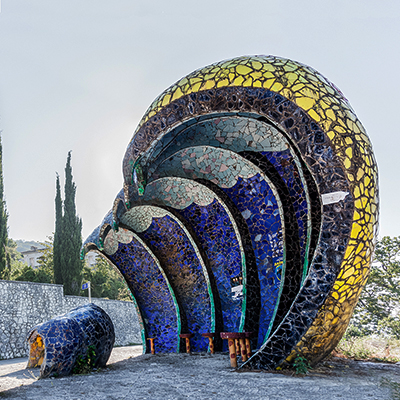It is not uncommon to find buildings and constructions that seem inspired by Gaudí’s work, even in countries whose cultures are so far from the context of Gaudí’s creation that it is not easy to find the common thread.
Such is the case of some bus stops and other buildings located in Georgia, a state situated in the Caucasus on the shores of the Black Sea, whose shapes and decorative coverings immediately refer to the works of the Catalan architect, especially Park Güell and other contemporary designs. They are notable compositions endowed with great formal freedom and covered with techniques similar to trencadís that can be appreciated in the magnificent photographs of Christopher Herwig, who toured for years the countries that formerly formed the Soviet Union portraying buildings that aroused his interest, compiled in two interesting books (1).
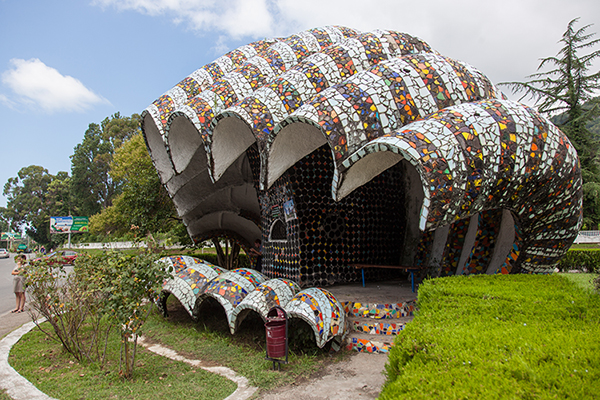
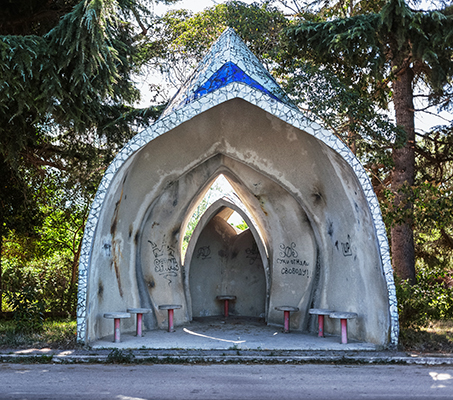

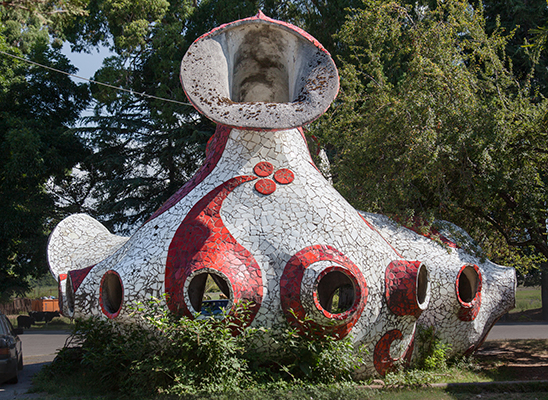
Bus stopt in Gagra, Novi Afon and motorway to Bichvinta, Georgia. Photos: Christopher Herwig. Soviet Bus Stops. Vol. I and II. FUEL Publishingh. London. 2015 https://fuel-design.com/publishing/

Herwig points to the famous Georgian artist Zurab Tsereteli as the author of these constructions. A Georgian publication from 2019 (2) that investigates the profuse use of decorative mosaics in Georgia during the Soviet period tells us that the author of the project for those bus stops and other notable constructions that recall the work of Gaudí was the architect George Chakhava, who served as Deputy Minister for Road Construction and Chief Architect of the Road Administration between 1967 and 1987, and local artists Zurab Kapanadze, Zurab Lezhava and Nodar Malazonia collaborated on the decoration.
The cooperation between these artists made emerge constructions that surpassed their utilitarian character to become true works of art that, like Gaudí’s buildings, synthesize functionality, form and structure, fusing architecture and decorative arts. They are “functional architectural sculptures” in the words of Kapanadze. That concept is evident at the Gagra, Novi Afon and Pitsunda bus stops. Another emblematic example of the use of decorative glazed coatings in Georgia is the “Café Fantasy” in Batumi, built in 1975 by the same authors, whose octopus shape gives it an organic appearance.
Many other ceramic decorations that are reminiscent of some Gaudinian creations can be found in the territory of Georgia. An example is the ventilation chimneys of the Gogilo baths in Tbilisi, the capital of Georgia, a work of Kukuri Tsereteli. The technique initially used was “smalti”, forming compositions with small pieces of colored opaque glass to create mosaics. This technique was imported from Ukraine and the Baltic countries and processed locally. Ceramic pieces or pebbles were also used with techniques similar to the originals. These artists later made an adaptation of the traditional Georgian enamelled coating using special colored glass produced in a Moscow factory.

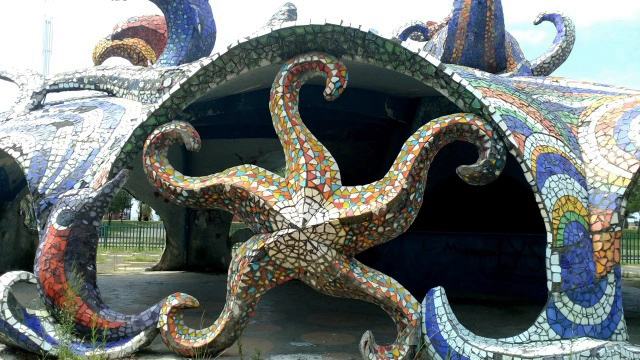
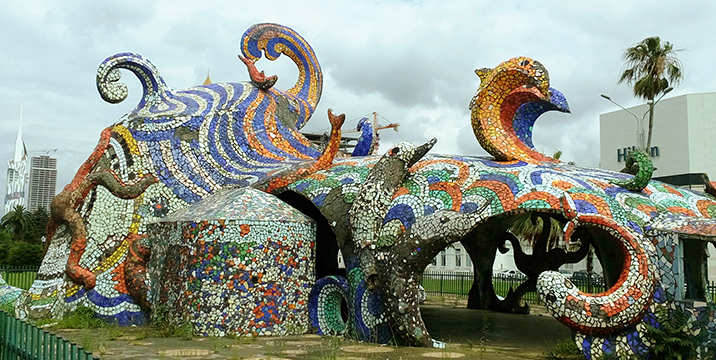
Gogilo bathhouse. Photo Evgenia Lysenkova and Café Fantasy. Batumi. Photos Marita Ratiani https://georgiaabout.com
The path of the possible inspiration in Gaudí’s work can begin in the impulse of muralism in the Soviet Union thanks to two great Mexican artists, Diego Rivera and David Alfaro Siqueiros, who had displayed that art on a large scale and with mixed techniques in various public buildings in their country. The USSR’s interest in incorporating mural art into propaganda led to their visit in the Soviet Union on several occasions. In 1955 during a trip to Moscow, Siqueiros, who in his youth lived for some time in Barcelona even during Gaudí’s lifetime, gave a lecture to the members of the Academy of Arts.
His influence on Georgian mural art that reached a generation of artists took place thanks to his relationship with Zurab Tsereteli, who interacted with Western artists after a trip to Paris in 1964 in which he established contact with Pablo Picasso, whose work combining various techniques greatly impressed him.
From that experience he began to combine architecture with monumental sculpture and three-dimensional compositions covered with chopped mosaics. It was when he was entrusted to work on important works on the shores of the Black Sea, where the Soviet government promoted the creation of spas, that he had the opportunity to develop all these concepts combined with the experiences of Mexican muralists. There is a photo of Siqueiros in front of a mosaic by the Georgian artist in 1970 in Sochi, a city in Russia very close to the border with Georgia (3). With these works Tsereteli laid the foundations for the reuse of monumental decorative mosaics in his country.
His subsequent works in the embassies of the USSR connected him to the most world-renowned artists, among others Oscar Niemeyer and Marc Chagall. His creations can be seen in European and American cities, his work being the subject of numerous exhibitions, in addition to receiving awards and distinctions. This unusual international activity for artists from the Soviet Union, added to his contact with artists from all over the world and his friendship with Siqueiros, allows us to conjecture a knowledge of Gaudí’s work that could have exerted some influence on his artistic creation. The work of Tsereteli, who currently presides over the Russian Academy of Arts, inspired artists and architects of his nation whose production seems to reflect formal and decorative aspects of that of the Catalan architect.
In addition to the aforementioned publications, Christopher Herwig’s photographs were the subject of a film released in 2022 that received numerous awards (4).
(1) Soviet Bus Stops. Vol. I and II. FUEL Publishingh. London. 2015 https://www.facebook.com/SovietBusstops/ https://www.instagram.com/soviet_busstops/
(2) Palavandishvili, Nini; Prents, Lena. Art for Architecture. Georgia. Soviet Modernist Mosaics from 1960 to 1990. Dom publishers. Berlin. 2019 https://issuu.com/designini/docs/691-0_english_180919_georgia_6910
(3) Palavandishvili, N. and Prents, L. (2019) P. 10
(4) Herwig, Christopher. Soviet Bus Stops. 2022 Empty Chairs / 291 Film Company Inc. https://www.sovietbusstops.com/
Special thanks to Christopher Herwig herwigphoto.com https://www.facebook.com/herwigphoto/ https://www.instagram.com/herwig_photo/

